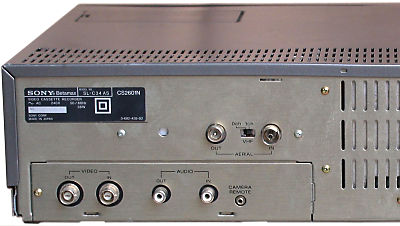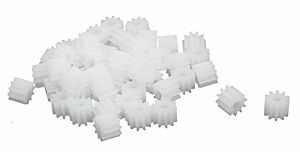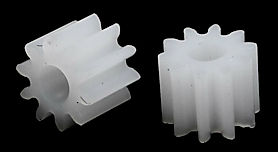Technical
 Rear view
|
Stops in play or recordThis is becoming a more common problem these days. The first thing to check is that there is adequate torque on the take up spool. If there isn't much then the cause is usually down to two contributing factors.The first is the drive pendulum which can cease up and the second more serious factor, is wear on the reel motor bottom bearing. The pendulum is simple to replace but the bearing is moulded into the chassis and replacement necessitates that the entire chassis be replaced. One possible compromise is to fit a small piece of plastic into the bottom bearing to raise the rotor and allow it to move freely. Sony supply a repair kit for this purpose. The repair is as follows: you remove the rotor. Then drop the shim (or small ball bearing) into the hole where the spindle fits. Next you take a file to the bottom of the spindle and gently grind it down until the stator (electro magnets) and rotor (permanent magnets) gap is correct again. This can be tested by spinning the rotor gently with one finger. The rotor should make 3 or more complete rotations with a gentle push. There's no need to remove the motor pcb. The bearing is integral to the chassis and nothing is gained by removing the pcb. To remove the rotor you just pull. You need to do so strongly and evenly so that you have no sideways movement. The diagram shows the pendulum assembly. Stops in play, record and reverse/forward windDo not confuse this with the above symptoms. The problem in this case is due to lack of 4.43MHz colour sub-carrier reference in the servo circuit. This in turn is normally caused by failure of silicon fuse PS1 on the YC-25 board.Patterning on pictureIf you experience a patterning on the picture irrespective of whether you are viewing a tape or not then the most likely cause is that capacitor C319 in the power supply has dried up.Deck goes into rewindThis can be caused by failure of the tape end sensor. You can check this by unplugging the sensor at its socket on the PCB. | |
 Hall effect sensor attached with glue |
No head drum rotationYou may find that the head drum fails to rotate. This is due to a problem with the Hall effect device on the head drum motor which is secured by a blob of glue. Full details on how to fix this can be found on the head motor page. |
|
|
|
Loading gear and shaft repairThe loading shaft for the Sony has no official replacement but most times it can be repaired, unless the gear is in two pieces or a tooth has broken off. There are two approaches to solve this, either repair the broken gear, or purchase a similar gear and adapt it to fit.
In practice the diameter is sufficient and the reduced length does not really matter, just use super glue (or other suitable glue) to glue them to the shaft and protrude the shaft 1mm or so past the end.
See: RC-Toy-Car gears
If you don't need 50 then look for a smaller quantity but the price does not seem to change much.
| |
Quick fault guide
Please click on the button if you are able to contribute a solution to this list or would like to add to, or update PALsite's information on this model. Please note, questions will be removed.If you have a question about this model, please raise it on the chatpage.
| Fault | Solution |
|---|---|





